Answer these simple questions and we will find you the BEST prices
Which type of solar quotes do you need?
It only takes 30 seconds
100% free with no obligation

Get Free quotes from insulation specialists near you

Save money by comparing quotes and choosing the most competitive offer

The service is 100% free and with no obligation
- GreenMatch
- Insulation
- Insulating Your House
- Insulate Flat Roof From Inside
How to Insulate a Flat Roof From the Inside (A UK Guide)

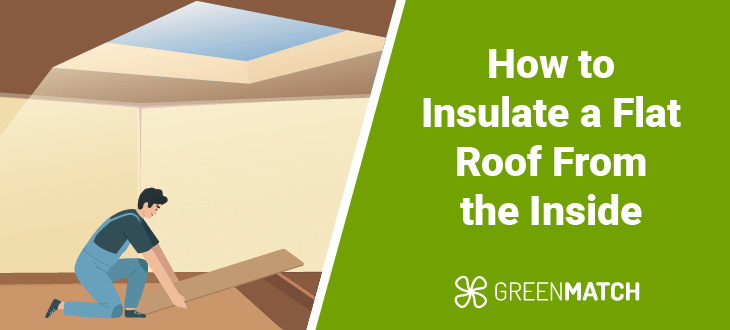
- Uninsulated flat roofs lose around one-quarter of heat due to inefficient thermal retention from exposure to extreme temperatures.
- Flat roof insulation from the inside involves installing insulation at the ceiling level over and between the ceiling joists.
- The average cost of insulating a flat roof ranges from £30 to £35 per m2. However, these costs can be minimised by insulating the flat roof from the inside, as it requires fewer materials and less labour.
- DIY flat roof insulation disqualifies you from government grants, which require certified PAS 2030–2035 installers to complete the work.
Insulating a flat roof from the inside is cost-effective, especially when external insulation isn't possible due to structural or budget limits. Flat roofs often have poor energy efficiency, as their surfaces are exposed to extreme temperatures, causing heat loss.
In fact, up to one-quarter of a home's warmth can escape through an uninsulated roof, resulting in a less comfortable living environment and significantly higher energy bills. With the average annual energy cost in the UK hovering around £1,625 and 40% of people struggling to keep up with their energy expenses, according to the 2024 National Statistics survey, knowing how to insulate a flat roof from the inside becomes increasingly vital.
This guide on insulating a flat roof from the inside covers effective methods, materials, and steps to ensure energy efficiency. Whether DIY or professional, this article equips you with the knowledge to achieve optimal insulation results.
Ready to enhance your flat roof insulation? Let GreenMatch UK assist you! Fill out our quick 30-second form to receive up to 4 free quotes from trusted, professional installers in your area. Avoid the hassle of researching and vetting, and discover the best deals available. Click below to learn more.
Fill in the form in just 1 minute
How to insulate a flat roof from the inside
Flat roof insulation from the inside, or cold loft insulation, involves installing insulation at the ceiling level over and between the ceiling joists. Ideal for storage-only lofts, this cost-effective method completes in two hours, leaving the attic uninsulated and matching external temperatures.
By focusing on internal insulation, homeowners can achieve energy efficiency without the higher costs associated with external insulation techniques. Here’s a step-by-step guide on insulating a flat roof from the inside to enhance your home's thermal performance.
Step 1: Assess the roof condition
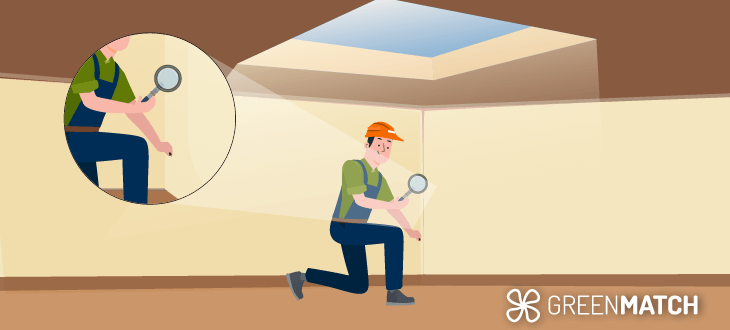
Before you begin insulating, it's important to carefully check the attic for any damage, leaks, or moisture problems. Moisture in the attic can affect the insulation, reducing its effectiveness and increasing the risk of mould or mildew growth. Make sure to fix any issues before insulating to provide a solid base for the work. Insulating over damaged ceiling joists can cause additional structural damage and lead to expensive repairs.
Step 2: Check building regulations
Your insulation plan should align with local building regulations when considering how to insulate a flat roof from the inside. Insulating a flat roof from the inside doesn't alter the external appearance or need a permit but must meet specific standards.
In the UK, roof insulation building regulations state that loft insulation should be installed at a thickness of 270mm to achieve a U-value of 0.18 W/m²K or lower. The U-value measures how well a material prevents heat loss; lower values mean better insulation and energy efficiency.
Step 3: Prepare work area
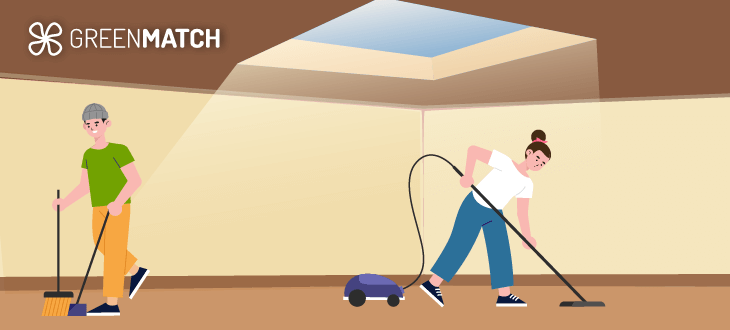
When insulating a flat roof from the inside, first remove items from the loft and ensure the space is clean. Use a vacuum cleaner to eliminate dust and debris, creating a clean and safe working environment. If there is pre-existing insulation that is no longer effective, be sure to remove it.
Identifying and marking the location of electrical wiring is crucial before beginning the insulation process. Clip the wires to roof joists to protect them during installation and keep them accessible for future maintenance.
Additionally, if your home was built between the 1930s and the 1980s, be aware that pre-existing insulation may contain asbestos, according to Armco. If you suspect the presence of asbestos, do not disturb the material. Seek professional assistance immediately to ensure safety and compliance when insulating a flat roof from the inside.
Step 4: Plan the layout
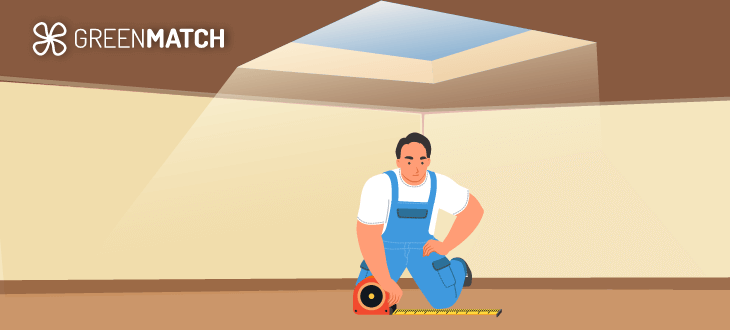
Measure your roof space to determine how much insulation material you'll need. To do this measure the area between the ceiling joists where the insulation will be installed. Mark these areas to ensure precise placement of the insulation material.
Step 5: Lay down plywood or OSB sheathing
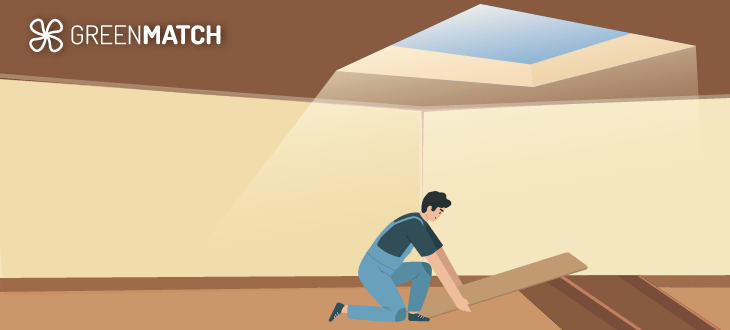
After preparing your loft space, you'll need to add 12 mm plywood or OSB sheathing. This will create a solid and stable base, distributing the load evenly across the timber joists and enhancing the roof's overall structural integrity.
These boards will provide a smooth and uniform surface for the subsequent layers of cold loft insulation. A consistent surface is essential for properly installing insulation and waterproofing materials, as they need to lie flat and adhere well to prevent gaps, air pockets, and potential leaks.
Step 6: Install a vapour barrier
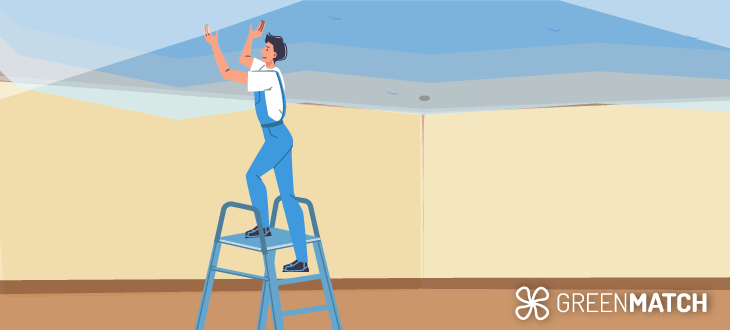
Installing a vapour barrier is vital when insulating a flat roof from the inside, especially with cold roof insulation. It prevents moisture condensation, avoiding mould and reduced insulation effectiveness. Lay the barrier across the ceiling, securing it tightly to the joists to eliminate gaps.
Additionally, it's important to mark the locations where fixings will pierce the vapour barrier. At each of these points, apply a sealant tape, such as butyl tape, to create a secure seal around the penetrations. This added step helps maintain the integrity of the vapour barrier, preventing moisture from entering and compromising the insulation. Properly managing moisture is key to ensuring long-term effectiveness when considering how to insulate a flat roof from the inside.
Step 7: Install the insulation between the joists
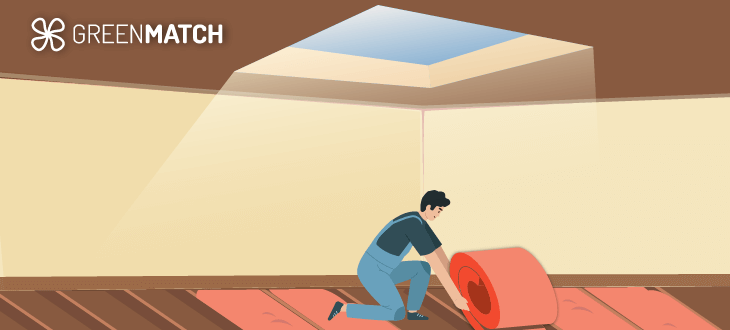
Carefully cut insulation materials like fibreglass, mineral wool, or foam boards to fit snugly between ceiling joists. When insulating a flat roof from the inside, start by insulating the eaves, leaving a 25mm ventilation gap.
Measure the width of the insulation material to fit precisely between the joists, which typically ranges from 400mm to 600mm. The insulation must fit tightly without being compressed, as compressing the material would diminish its insulating properties. The insulation should fully occupy the space between the joists, effectively eliminating any potential for thermal bridging.
To achieve the optimal roof insulation thickness of 270mm when learning how to insulate a flat roof from the inside, apply additional layers on top of the initial layer, positioning them perpendicular to the joists. This method helps to close any remaining gaps and significantly improves the overall thermal efficiency of the insulation.
Curious about how much roof insulation you'll need? Check out the linked article.
Step 8: Seal gaps and edges
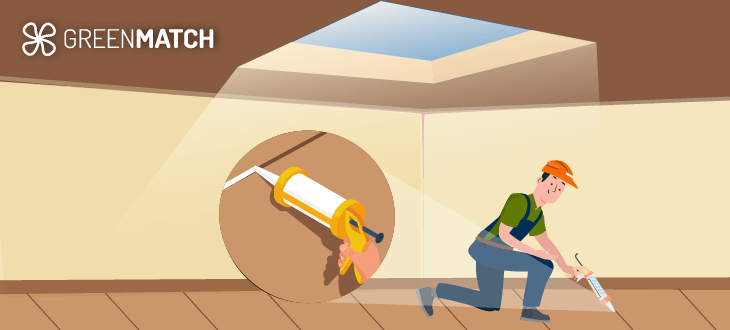
Use a high-quality sealant to seal any gaps or edges around the insulation. This step is essential to prevent air leaks and ensure the insulation performs optimally. Pay special attention to areas around pipes, cables, and other penetrations through the ceiling.
If necessary, cover the insulated area with a ceiling finish like plywood to enhance the appearance and add an extra layer of insulation.
Step 9: Inspect and finish
Once the insulation is installed, inspect the entire area to ensure there are no gaps or areas where the insulation might not perform effectively. Ensure the vapour barrier is intact and the insulation securely in place.
Following these steps for insulating a flat roof from the inside ensures effective cold roof insulation and a more energy-efficient home. This method effectively reduces heat loss and manages energy costs, making it a smart investment.
Materials for insulating a flat roof from inside

When considering how to insulate a flat roof from the inside, selecting the best roof insulation materials is crucial for achieving both effective thermal performance and long-term durability. While there are many types of insulation for roofs, only a few are suitable for insulating a flat roof from the inside. These include:
- Spray foam insulation
- Mineral wool
- Extruded polystyrene (XPS)
- Polyisocyanurate (PIR) boards
Spray foam insulation requires professional installation due to specialized equipment and techniques, making it unsuitable for DIY projects
Choose materials that can withstand decking weight and pressure when insulating a flat roof from the inside to prevent damage. Moisture resistance is also vital in cold roofs to avoid insulation degradation, mould growth, and the loss of insulating properties. Because the entire loft space won’t be insulated, selecting insulation materials with a high R-value is essential to maximise thermal efficiency.
On average, flat roof insulation costs between £30 to £35 per m2. However, insulating a flat roof from the inside can reduce costs since less material and labour are required. Labour costs typically run around £250 per person per day. Understanding the materials costs will help you plan how to insulate a flat roof from the inside within your budget.
| Material | Average cost per m2 |
|---|---|
| Polystyrene (EPS) board | £10 |
| Polyisocyanurate (PIR) board | £12.50 |
| Mineral wool | £33.45 |
| Spray foam | £62.50 |
DIY vs professional flat roof insulation
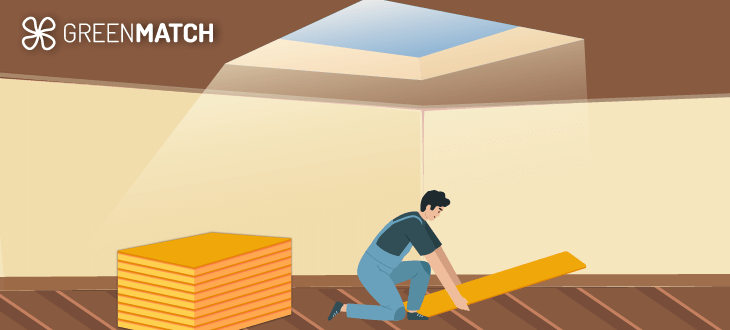
When considering how to insulate a flat roof from the inside, you may be weighing the options between a DIY approach and hiring professional roof insulation installers. While DIY insulation can be a cost-effective solution, it is essential to note the pros and cons of DIY insulation:
Pros
- Cost savings: DIY flat roof insulation saves on labour costs. Professional installation can be expensive at £250 per person per day. By doing it yourself, you can significantly reduce overall costs.
- Control over the project: DIY insulation allows you to work at your own pace and on your schedule. You have control over the project, including materials and adjustments, which is beneficial for spreading the work over several weekends or adapting it to your needs.
- Sense of accomplishment: Insulating your flat roof from the inside can improve your home's comfort and energy efficiency, providing personal satisfaction and pride in your work.
Cons
- Risk of improper insulation: DIY insulation can be improperly installed, leading to heat loss, moisture build up, and costly repairs.
- Lack of specialised equipment: Professional installers use specialised equipment to apply insulation materials precisely, especially for challenging tasks such as insulating hard-to-reach areas or using spray foam. Without the right tools, achieving the same precision and effectiveness can be difficult for a DIYer.
- Handling hazardous materials: Some insulation materials, like mineral wool, can be dangerous if improperly handled. You risk skin irritation, respiratory issues, or other health problems during installation without proper protective gear and knowledge.
- No warranty available: Installing insulation yourself means no professional warranty. If issues arise later, you'll be responsible for addressing them, leading to additional costs and effort. In contrast, professionals offer warranties, providing peace of mind.
- No access to grants: In the UK, grants for insulations are only available when certified PAS 2030 – 2035 installers carry out the work. Since DIY loft insulation does not qualify for these grants, opting for a professional installation could save you money.
When deciding how to insulate a flat roof from the inside, professional installation offers expertise, specialised material handling, access to specific insulation types, and eligibility for government grants. At GreenMatch, we can connect you with top flat roof insulation specialists, saving you time and effort when comparing quotes. Fill out our quick form for four free quotes. Click below to find out more.
Fill in the form in just 1 minute
FAQ
Yes, you can insulate a flat roof from the inside by installing insulation materials like rigid foam boards, mineral wool, or spray foam between the ceiling joists. This method improves thermal efficiency while leaving the loft space cold and helps reduce energy costs while maintaining the roof’s structural integrity.
To insulate an existing flat roof from the inside, first, inspect the loft for any damage that may need repair. Next, install a vapour barrier to prevent moisture build up. Then, measure and fit the insulation material between the loft joists, starting at the eaves and leaving a 25mm gap for ventilation. Ensure the insulation fits snugly without gaps. Finally, add a second layer of insulation perpendicular to the joists for enhanced thermal efficiency, and seal all edges and gaps to prevent air leaks.

Caoimhe is an experienced content writer and researcher who is passionate about providing accessible information to every reader. With a background in English literature and Sociology, she combines the two disciplines to create cohesive, well-thought-out, and well-informed pieces.
We strive to connect our customers with the right product and supplier. Would you like to be part of GreenMatch?

